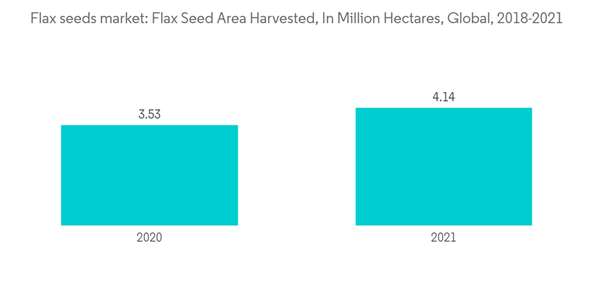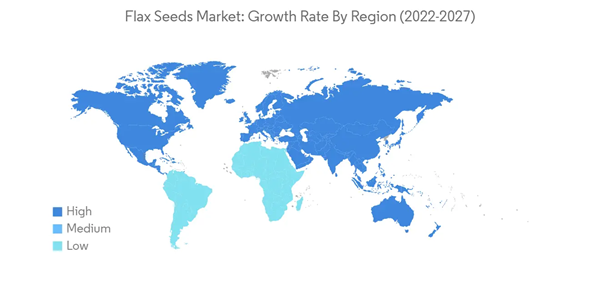The Flaxseeds Market size is estimated at USD 0.89 billion in 2024, and is expected to reach USD 1.54 billion by 2029, growing at a CAGR of 11.57% during the forecast period (2024-2029).
Flax seed is one of the world's richest known plant sources of Omega-3. For instance, flax seed naturally contains 40% oil, of which 55% is Omega-3 essential oil that benefits both animals and humans, improving metabolic processes, stamina, immunity, etc. Furthermore, the increased availability of "superfoods," including flaxseeds' in supermarkets, traditional grocery stores, and convenience stores has increased the demand for flax seeds in developing countries over the past few years.
The rising demand for flax seeds worldwide has led to an increase in global flax seed production. According to FAOSTAT, the world harvested area of flax seed has increased by over 31% from 3.14 million hectares in 2018 to 4.14 million hectares in 2021. Therefore, the increasing demand for flax seeds due to associated health benefits and usage as superfoods, along with the increased global production, is anticipated to drive the flax seed market in the coming years.
According to ITC Trade Map, the value of linseed exports of Kazakhstan has increased by over 50% during the period 2017-2021 reaching USD 226 Million in 2021. The Asia-Pacific region is also the largest consumer of flaxseed due to the presence of large populated and developing countries such as India and China. The demand is further anticipated to increase due to the rise in disposable incomes and the growing number of middle-class families in the region in recent years. Therefore, the increasing export value of flax seeds, consumption, and rising disposable incomes in the Asia-Pacific region is expected to drive the flax seed market.
This product will be delivered within 2 business days.
Key Highlights
- Flax seed or linseed is an annual herbaceous crop grown in the excellent season. In recent years, flax seed has gained popularity worldwide due to its fantastic health benefits and commercial usage. Besides its usage for edible purposes such as food and oil, flax seed is also being used in textile industries over the past few years. In the global market, flaxseeds can be used for crushing, which results in oil and flax meal production. It can also be used in the form of whole seeds, roasted, sprouted, and grounded seeds.
- Flaxseed oil and meal are used to produce human and animal food products. Flax oil is widely used in the industry for linoleum production, varnish, and ink production. As a result, Flax seeds are grown worldwide in different climate zones and countries due to their high demand and domestic and international markets.
- Kazakhstan, Russia, Canada, China, India, the United Kingdom, and the United States are some of the leading countries in global flax seed production. Furthermore, flaxseeds are a cheaper alternative to chia seeds and quinoa seeds for animal feed and industrial purposes, increasing global production. Therefore, the increasing usage of flax seeds due to their health benefits and use in industrial purposes driving global production are some of the factors anticipated to drive the flax seed market in coming years.
Flax Seed Market Trends
Growing Popularity of Super Foods is Driving the Market
The popularity of "super" ingredients has increased significantly over the recent past as consumers are more inclined toward natural and wholesome ingredients. These products have superior nutritional value as they are rich sources of polyphenols, antioxidants, vitamins, and minerals. Due to the high dietary fiber content of flax seeds, antioxidants, and protein, regular consumption of flaxseeds helps in good digestive functioning.Flax seed is one of the world's richest known plant sources of Omega-3. For instance, flax seed naturally contains 40% oil, of which 55% is Omega-3 essential oil that benefits both animals and humans, improving metabolic processes, stamina, immunity, etc. Furthermore, the increased availability of "superfoods," including flaxseeds' in supermarkets, traditional grocery stores, and convenience stores has increased the demand for flax seeds in developing countries over the past few years.
The rising demand for flax seeds worldwide has led to an increase in global flax seed production. According to FAOSTAT, the world harvested area of flax seed has increased by over 31% from 3.14 million hectares in 2018 to 4.14 million hectares in 2021. Therefore, the increasing demand for flax seeds due to associated health benefits and usage as superfoods, along with the increased global production, is anticipated to drive the flax seed market in the coming years.
Asia-Pacific Leads the Global Flaxseed Production
Asia-Pacific is the largest flaxseed-producing region in the world. Kazakhstan, China, India, Australia, and Iraq are the major producers and consumers of flaxseeds in the region. Kazakhstan alone accounts for about 37% of the total harvested area with over 1.34 million hectares in 2020 according to FAOSTAT. The growing global demand for flaxseed has increased its export potential over the past few years.According to ITC Trade Map, the value of linseed exports of Kazakhstan has increased by over 50% during the period 2017-2021 reaching USD 226 Million in 2021. The Asia-Pacific region is also the largest consumer of flaxseed due to the presence of large populated and developing countries such as India and China. The demand is further anticipated to increase due to the rise in disposable incomes and the growing number of middle-class families in the region in recent years. Therefore, the increasing export value of flax seeds, consumption, and rising disposable incomes in the Asia-Pacific region is expected to drive the flax seed market.
Flax Seed Industry Overview
Additional Benefits:
- The market estimate (ME) sheet in Excel format
- 3 months of analyst support
This product will be delivered within 2 business days.
Table of Contents
1 INTRODUCTION
4 MARKET DYNAMICS
5 MARKET SEGMENTATION (Production Analysis, Consumption Analysis by Value and Volume, Import Analysis by Value and Volume, Export Analysis by Value and Volume, and Price Trend Analysis)
Methodology

LOADING...










